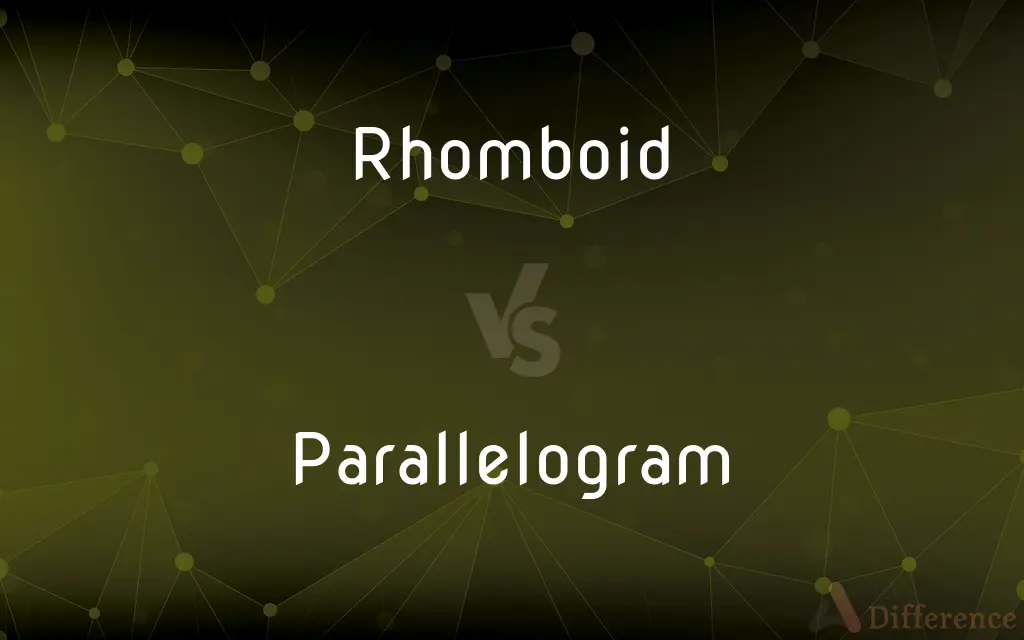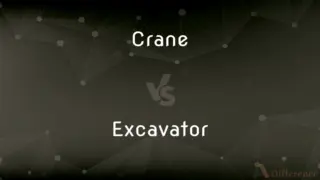Rhomboid vs. Parallelogram — What's the Difference?
By Tayyaba Rehman & Urooj Arif — Updated on March 11, 2024
A rhomboid is a parallelogram with no right angles and sides of unequal lengths, whereas a parallelogram has opposite equal angles and sides but not necessarily equal.

Difference Between Rhomboid and Parallelogram
Table of Contents
ADVERTISEMENT
Key Differences
A rhomboid is characterized by its oblique angles and unequal side lengths, making it a specific type of parallelogram. On the other hand, a parallelogram is defined by having opposite sides that are equal in length and parallel, but its angles and sides can vary, as long as the opposite sides and angles remain equal.
Rhomboids do not have all sides equal; typically, only the opposite sides are equal and parallel. Whereas, in parallelograms, such as squares and rectangles, all four sides can be equal (in the case of a square), or only the opposite sides are equal (in rectangles and general parallelograms).
The angles in a rhomboid are typically oblique, meaning they are not right angles. This is a distinctive feature that differentiates it from certain types of parallelograms like rectangles, which have right angles. Parallelograms, however, can have any angle as long as the opposite angles are equal.
The term "rhomboid" is often used to describe a shape that resembles a distorted rectangle or a parallelogram without right angles. In contrast, parallelogram is a broader term that includes shapes with right angles (rectangles) and those without (like rhombuses and rhomboids).
While rhomboids are always parallelograms due to their properties of having parallel opposite sides of equal length, not all parallelograms are rhomboids. This distinction is crucial because it highlights the specific conditions that define a rhomboid within the broader category of parallelograms.
ADVERTISEMENT
Comparison Chart
Sides
Unequal lengths, but opposite sides are equal
Opposite sides are equal, may or may not be of the same length
Angles
No right angles, opposite angles are equal
Opposite angles are equal, can include right angles
Symmetry
Less symmetrical than some parallelograms
Can be highly symmetrical (e.g., rectangles, squares)
Usage
Less common in geometry
Broad category in geometry, including squares and rectangles
Definition
A parallelogram without right angles and unequal adjacent sides
A quadrilateral with opposite sides parallel and equal in length
Compare with Definitions
Rhomboid
Not a common geometric figure in standard geometry, symbolizing a distorted parallelogram.
In nature, rhomboid crystals are rare but fascinating.
Parallelogram
Can have right angles, as in the case of rectangles.
Despite its appearance, a rectangle is a type of parallelogram.
Rhomboid
A four-sided shape with opposite sides parallel and equal but no right angles.
The artist's latest sculpture features a complex arrangement of rhomboid panels.
Parallelogram
A quadrilateral with opposite sides that are parallel and equal in length.
A classic example of a parallelogram is the base of a standard desk.
Rhomboid
A parallelogram with oblique angles and unequal adjacent sides.
A rhomboid-shaped window often adds a unique character to a building's facade.
Parallelogram
Includes shapes like rectangles, squares, and rhombuses.
The city's layout is based on a grid of parallelogram-shaped blocks.
Rhomboid
Typically lacks the symmetry of rectangles and squares.
The rhomboid muscle mirrors the shape's asymmetry, stretching under the shoulder blade.
Parallelogram
The opposite angles are equal, making it a versatile geometric figure.
Parallelogram properties are essential in proving many geometric theorems.
Rhomboid
Describes objects resembling a skewed rectangle.
The plot of land is rhomboid, challenging conventional architectural designs.
Parallelogram
Used to describe objects with parallel opposite sides.
The engineer designed a parallelogram mechanism for the new lift system.
Rhomboid
Traditionally, in two-dimensional geometry, a rhomboid is a parallelogram in which adjacent sides are of unequal lengths and angles are non-right angled. A parallelogram with sides of equal length (equilateral) is a rhombus but not a rhomboid.
Parallelogram
In Euclidean geometry, a parallelogram is a simple (non-self-intersecting) quadrilateral with two pairs of parallel sides. The opposite or facing sides of a parallelogram are of equal length and the opposite angles of a parallelogram are of equal measure.
Rhomboid
A parallelogram with unequal adjacent sides, especially one having oblique angles.
Parallelogram
A four-sided plane figure with opposite sides parallel.
Rhomboid
Shaped like a rhombus or rhomboid.
Parallelogram
(geometry) A convex quadrilateral in which each pair of opposite edges are parallel and of equal length.
Rhomboid
A parallelogram which is neither a rhombus nor a rectangle
Parallelogram
Either of two rectangular areas (respectively the large parallelogram and the small parallelogram) abutting the goal line in front of the goal. (Since 1986 officially named the large rectangle and small rectangle, though the older names are still occasionally used.)
Rhomboid
Any of several muscles that control the shoulders
Parallelogram
A right-lined quadrilateral figure, whose opposite sides are parallel, and consequently equal; - sometimes restricted in popular usage to a rectangle, or quadrilateral figure which is longer than it is broad, and with right angles.
Rhomboid
A solid shape which has rhombic faces
Parallelogram
A quadrilateral whose opposite sides are both parallel and equal in length
Rhomboid
Resembling, or shaped like a rhombus or rhomboid
Rhomboid
An oblique-angled parallelogram like a rhomb, but having only the opposite sides equal, the length and with being different.
Rhomboid
Same as Rhomboidal.
Rhomboid
A parallelogram with adjacent sides of unequal lengths; an oblique-angled parallelogram with only the opposite sides equal
Rhomboid
Any of several muscles of the upper back that help move the shoulder blade
Rhomboid
Shaped like a rhombus or rhomboid;
Rhomboidal shapes
Common Curiosities
How does a parallelogram differ from a rhomboid?
A parallelogram is a broader category that includes any quadrilateral with parallel and equal opposite sides, including rhomboids, but not limited to them.
Do rhomboids have equal angles?
Only opposite angles are equal in a rhomboid.
What geometric shapes fall under the category of parallelograms?
Shapes like squares, rectangles, rhombuses, and rhomboids.
Can a parallelogram have unequal adjacent sides?
Yes, as in the case of rhomboids and general parallelograms.
Are all rhomboids parallelograms?
Yes, all rhomboids are parallelograms, but not all parallelograms are rhomboids.
What is the main use of parallelograms in geometry?
To study properties of quadrilaterals with parallel sides, useful in various geometric proofs and constructions.
What defines a rhomboid?
A rhomboid is a parallelogram with oblique angles and unequal adjacent sides.
Can a square be considered a parallelogram?
Yes, a square is a type of parallelogram with all sides and angles equal.
What makes a rhomboid unique among parallelograms?
Its lack of right angles and unequal adjacent sides.
Can rectangles be classified as parallelograms?
Yes, rectangles are parallelograms with right angles and equal opposite sides.
How are rhombuses and rhomboids different?
Rhombuses have all sides equal and typically have oblique angles, whereas rhomboids have unequal adjacent sides.
Why are parallelograms important in real-world applications?
They are foundational in engineering, architecture, and design, facilitating the understanding of structural dynamics and spatial planning.
What role does symmetry play in distinguishing between rhomboids and other parallelograms?
Symmetry, especially in terms of equal sides and angles, is more pronounced in parallelograms like squares and rectangles, compared to rhomboids.
Is it possible for a parallelogram to have all angles equal?
Yes, when it is a rectangle or square, both of which are types of parallelograms.
Are the diagonals of a rhomboid equal?
No, the diagonals of a rhomboid are not equal, which differentiates it from squares and rectangles.
Share Your Discovery

Previous Comparison
Crane vs. Excavator
Next Comparison
Insignia vs. RegaliaAuthor Spotlight
Written by
Tayyaba RehmanTayyaba Rehman is a distinguished writer, currently serving as a primary contributor to askdifference.com. As a researcher in semantics and etymology, Tayyaba's passion for the complexity of languages and their distinctions has found a perfect home on the platform. Tayyaba delves into the intricacies of language, distinguishing between commonly confused words and phrases, thereby providing clarity for readers worldwide.
Co-written by
Urooj ArifUrooj is a skilled content writer at Ask Difference, known for her exceptional ability to simplify complex topics into engaging and informative content. With a passion for research and a flair for clear, concise writing, she consistently delivers articles that resonate with our diverse audience.














































